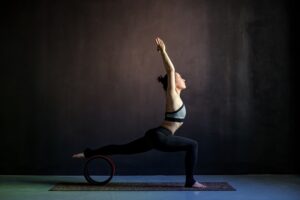Yoga Wheel Guide:
What is a Yoga wheel?
It is a relatively new, practical, and fun accessory for all practitioners of the yoga discipline.
In recent years, many yogi’s have started using the wheel as another prop to improve their practice.
Oftentimes, you’ll find all sorts of tutorials and poses on the utilization of a yoga wheel on platforms such as YouTube and Instagram.

History & Use of the Wheel for Yoga:
Designed in 2015, the yoga wheel has become one of the most popular accessories for yoga practitioners in recent years. Contrarily to belief, not just popular to experienced yogi’s, but also to more novice practitioners within the practice.
Goal:
The yoga wheel helps support the body in its movements and guides it safely into the most correct position. Furthermore, used in gyms across the country and even for massage, the yoga wheel has revolutionized the daily life of some fitness enthusiasts.
The yoga wheel is made of ultra-resistant material. Oftentimes, supporting weight up to 200 kilos. The a market for a yoga wheel has indeed expanding to include; wood, & plastic, and many different color selections.
So how do you pick one that fits your body and style? If you want a yoga wheel to truly become an ally of well-being, its important to choose the correct size, Most importantly is making sure to utilize a wheel that fits snuggly between the shoulder blades. However, we’ll discuss this aspect more in a later post.
What are the Benefits of a Yoga Wheel?
Easy to use, the yoga wheel attracts both experienced practitioners and beginners. Ideal for transforming your yoga session, this accessory can really change the practice. It allows you to go further in stretching and makes it possible to perform more advanced postures.
According to many practitioners, the yoga wheel deeply stretches the body, further helping to develop and maintain flexibility. For example, it can help open the rib cage, shoulders, and relieve accumulated tension and aches throughout much of body. A yoga wheel can be used for both standing and seated positions. Oftentimes, not just making them versatile, but helping to improve balance postures as well, in a safe and effective manner.
In addition, with many maneuvers, the yoga wheel can act as a gentle message. Specifically, for asanas that require lying on the wheel, arching the back overtop. Using bodyweight on top the wheel, in this instance, can help work out knots and really hit the area of the spine. In fact, pregnant women can utilize this very function to help relieve back pain.
Yoga Wheel Back Stretches:
Oftentimes, the wheel is placed behind the back, in a sort of upright position. This position can also help open the chest and shoulders. In addition, with slight variations in position placement, targeting and helping to stretch other areas of the torso or core. Maybe most notably, the wheel can help to increase spinal flexibility and elongation.
Furthermore, as you become better at it’s use, experimenting with raising your arms overtop your head, and placing your hands in prayer-type position. Then, slowly allowing them to fall closer and closer to the mat. Hence, providing even more stretch.
Alternatively, flip around on all fours. Place one hand palm down on top of the wheel. Then, bring your chest and forehead toward the mat. This allows for another way to stretch the shoulders.
Verticals and Inversions:
Not for the faint of heart, and most likely not for the novice either, is using the wheel for verticals and inversions. Specific to handstands, the position of the yoga wheel must always be vertical. Grab with your hands, placing your elbows parallel to one other. At this time attempt to go up vertically. The wheel acts as a support for climbing (grabbing it with your hands will make it easier to find stability). To further increase the stability of the position, place a block on the other side of the wheel, or perform close to the wall. The wheel can rest against the wall in this scenario.
To Improve Balance:
Watch as she walks us through some great balancing maneuvers using the wheel
The cylindrical nature of the yoga wheel also makes it a favorable tool for balancing maneuvers. Thus, helping to activate and work on the smaller stabilizer muscles (i.e. Garland pose). Once your strength and stamina improve, your balance with follow.
Make sure to activate and engage the core in all balancing asanas, with tremendous focus on breathing. In this case of Garland pose, proceed in taking one foot at a time from the mat to position it over the wheel. The feet are both rotated outwards. The goal is to open the hips and go down with the pelvis towards the wheel. The practitioner can utilize their arms to also open up the hips. Join the hands in prayer in front of the heart, pushing the elbows against the inner part of the thighs.
Final Thoughts!
The yoga wheel is a very useful support that can be used for different purposes. The important thing is to always listen to your body. Practice according to your own limits! Embrace them, respect them, and let the yoga wheel be a precious tool to explore your body from a different perspective!
Namaste




